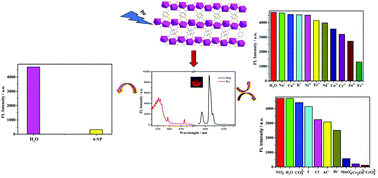A water-stable lanthanide coordination polymer as a multiresponsive luminescent sensor for Fe3+, Cr(vi) and 4-nitrophenol†
Abstract
Constructing water stable lanthanide coordination polymers (Ln-CPs) is of great importance for practical applications in biological and environmental areas and necessary for systematic research on the relationship between the properties of Ln-CPs and structures of linker ligands. A two-dimensional (2D) Eu coordination polymer (Eu-CP) {[Eu(L)(HCOO)]·H2O}n (H2L = isomer of 5-((pyridin-3-yloxy)methyl)isophthalic acid) is synthesized by the reaction of Eu(NO3)3·6H2O and H2L and heating at 140 °C. Single crystal X-ray diffraction analysis indicates that the Eu-CP presents a 2D network structure formed by binuclear metal clusters and bridged linkers COO– and HCOO–. The luminescence properties of the Eu-CP are explored at room temperature in the solid-state. The Eu-CP emits bright and stable red light due to the antenna effect from the ligand to the metal ion. The characteristic emission peaks of Eu3+ can be observed in its spectra. The luminescence intensity of the Eu-CP can be sensitively quenched by inorganic ions Fe3+, CrO42−, and Cr2O72− and the organic molecule 4-nitrophenol (4-NP). The Eu-CP can be a multiresponsive luminescent sensor in the water phase. Solvent luminescence investigation and PXRD data demonstrate that the Eu-CP exhibits excellent water stability. Therefore, all the sensing experiments are carried out in the water system. This multi-responsive luminescent sensor can detect Fe3+, Cr(VI) or 4-NP with high sensitivity and low detection limits in aqueous solution. Furthermore, the mechanism for the selective sensing of Fe3+, Cr(VI) or 4-NP is also explored which can mainly be explained by energy competition between the absorption of the analytes and the excitation of the Eu-CP.



 Please wait while we load your content...
Please wait while we load your content...